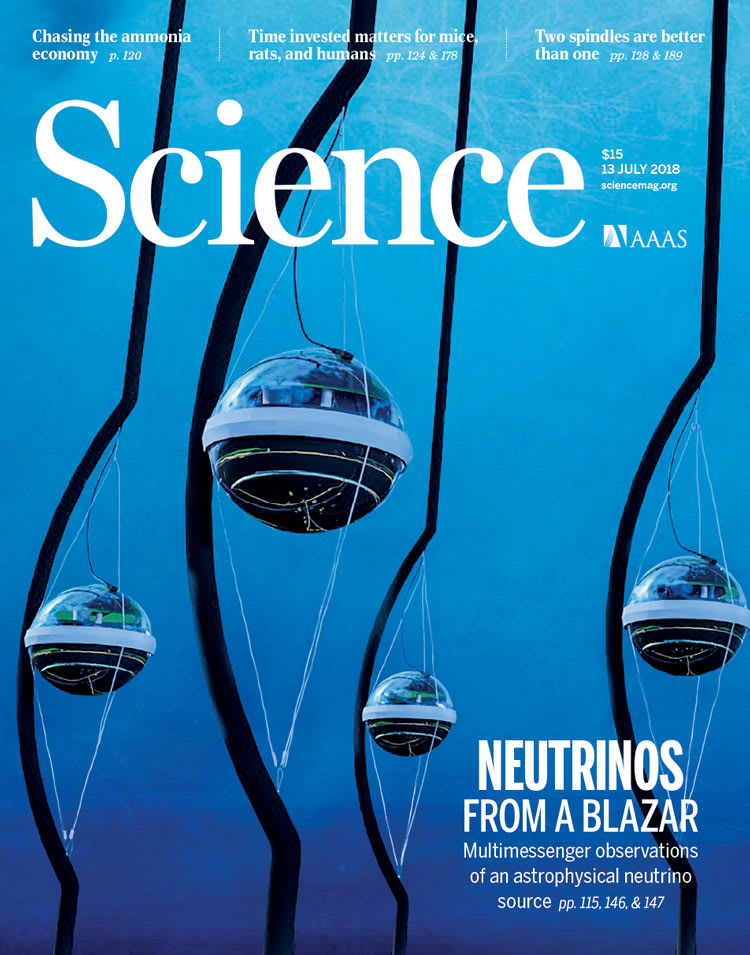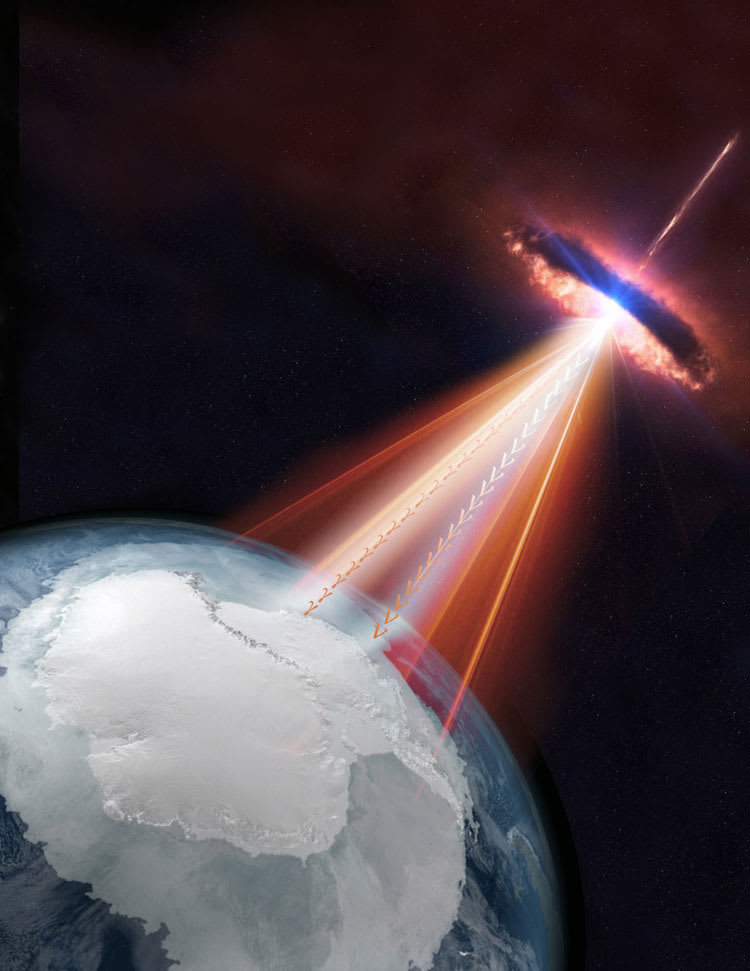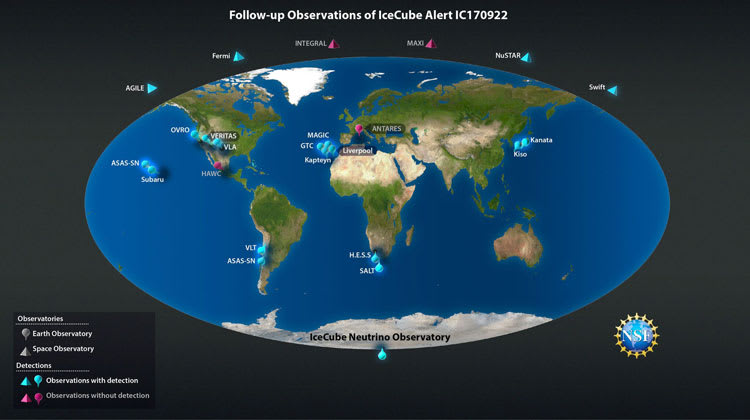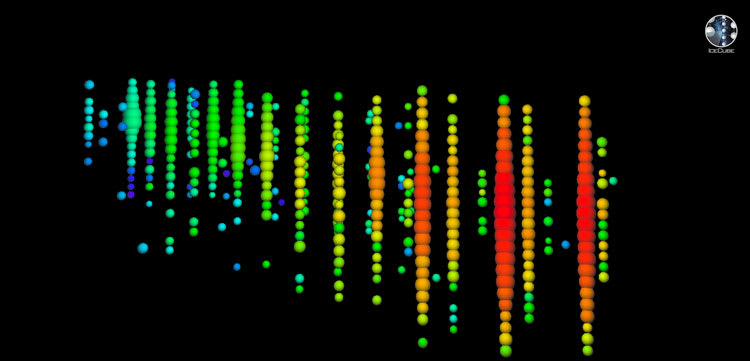An international team of scientists has found the first evidence of a source of high-energy cosmic neutrinos, ghostly subatomic particles that can travel unhindered for billions of light years from the most extreme environments in the universe to Earth.
The observations, made by the IceCube Neutrino Observatory at the Amundsen–Scott South Pole Station and confirmed by telescopes around the globe and in Earth’s orbit, help resolve a more than a century-old riddle about what sends subatomic particles such as neutrinos and cosmic rays speeding through the universe.

Since they were first detected over one hundred years ago, cosmic rays—highly energetic particles that continuously rain down on Earth from space—have posed an enduring mystery: What creates and launches these particles across such vast distances? Where do they come from?
Because cosmic rays are charged particles, their paths cannot be traced directly back to their sources due to the powerful magnetic fields that fill space and warp their trajectories. But the powerful cosmic accelerators that produce them will also produce neutrinos. Neutrinos are uncharged particles, unaffected by even the most powerful magnetic field. Because they rarely interact with matter and have almost no mass—hence their sobriquet “ghost particle”—neutrinos travel nearly undisturbed from their accelerators, giving scientists an almost direct pointer to their source.
Two papers published this week in the journal Science have for the first time provided evidence for a known blazar as a source of high-energy neutrinos detected by the National Science Foundation-supported IceCube observatory. This blazar, designated by astronomers as TXS 0506+056, was first singled out following a neutrino alert sent by IceCube on Sept. 22, 2017.
“The evidence for the observation of the first known source of high-energy neutrinos and cosmic rays is compelling,” says Francis Halzen, a University of Wisconsin–Madison professor of physics and the lead scientist for the IceCube Neutrino Observatory.
“The era of multimessenger astrophysics is here,” said NSF Director France Córdova. “Each messenger—from electromagnetic radiation, gravitational waves and now neutrinos—gives us a more complete understanding of the universe, and important new insights into the most powerful objects and events in the sky. Such breakthroughs are only possible through a long-term commitment to fundamental research and investment in superb research facilities.”

A blazar is a giant elliptical galaxy with a massive, rapidly spinning black hole at its core. A signature feature of blazars is that twin jets of light and elementary particles, one of which is pointing to Earth, are emitted from the poles along the axis of the black hole’s rotation. This blazar is situated in the night sky just off the left shoulder of the constellation Orion and is about 4 billion light years from Earth.
Equipped with a nearly real-time alert system—triggered when a very high-energy neutrino collides with an atomic nucleus in the Antarctic ice in or near the IceCube detector—the observatory broadcast coordinates of the Sept. 22 neutrino alert to telescopes worldwide for follow-up observations. Gamma-ray observatories, including NASA’s orbiting Fermi Gamma-ray Space Telescope and the Major Atmospheric Gamma Imaging Cherenkov Telescope, or MAGIC, in the Canary Islands, detected a flare of high-energy gamma rays associated with TXS 0506+056, a convergence of observations that convincingly implicated the blazar as the most likely source.

Fermi was the first telescope to identify enhanced gamma-ray activity from TXS 0506+056 within 0.06 degrees of the IceCube neutrino direction. In a decade of Fermi observations of this source, this was the strongest flare in gamma rays, the highest-energy photons. A later follow-up by MAGIC detected gamma rays of even higher energies.
These observations prove that TXS 0506+056 is one of the most luminous sources in the known universe and, thus, add support to a multimessenger observation of a cosmic engine powerful enough to accelerate high-energy cosmic rays and produce the associated neutrinos. Only one of these neutrinos, out of many millions that sailed through Antarctica’s ice, was detected by IceCube on Sept. 22.

Bolstering these observations are coincident measurements from other instruments, including optical, radio, and X-ray telescopes. “The ability to globally marshal telescopes to make a discovery using a variety of wavelengths in cooperation with a neutrino detector like IceCube marks a milestone in what scientists call multimessenger astronomy,” says Halzen
“These intriguing results also represent the remarkable culmination of thousands of human years of intensive activities by the IceCube Collaboration to bring the dream of neutrino astronomy to reality,” says Darren Grant, a professor of physics at the University of Alberta and the spokesperson of the IceCube Collaboration, an international team with over 300 scientists in 12 countries.
Austrian physicist Victor Hess proved in 1912 that the ionizing particles scientists were detecting in the atmosphere were coming from space. Cosmic rays are the highest energy particles ever observed, with energies up to a hundred million times the energies of particles in the Large Hadron Collider at CERN in Switzerland, the most powerful human-made particle accelerator. These extremely high energy cosmic rays can only be created outside our galaxy and their sources have remained a mystery until now. Scientists had speculated that the most violent objects in the cosmos, things like supernova remnants, colliding galaxies, and the energetic black hole cores of galaxies known as active galactic nuclei, such as blazars, could be the sources.
“Fermi has been monitoring some 2,000 blazars for a decade, which is how we were able to identify this blazar as the neutrino source,” says Regina Caputo, the analysis coordinator for the Fermi Large Area Telescope collaboration. “High-energy gamma rays can be produced either by accelerated electrons or protons. The observation of a neutrino, which is a hallmark of proton interactions, is the first definitive evidence of proton acceleration by black holes.”
“Now, we have identified at least one source of cosmic rays because it produces cosmic neutrinos. Neutrinos are the decay products of pions. In order to produce them, you need a proton accelerator,” says Halzen.
Cosmic rays are mostly protons and are sent speeding across the universe because the places where they are created act in the same way as particle accelerators on Earth, only they are far more powerful. “Theories predict that the emission of neutrinos will be accompanied by the release of gamma rays,” explains Razmik Mirzoyan, the spokesperson of the MAGIC Collaboration. But there are still a lot of questions on how blazars could accelerate particles to such high energies. “Gamma radiation provides information on how the ‘power plants’ in supermassive black holes work,” adds Mirzoyan.
As the latest astrophysical messenger to enter the game, neutrinos bring crucial new information to uncovering the inner workings of these cosmic ray accelerators. In particular, measurements of neutrinos can reveal the mechanisms for particle acceleration of the proton beam in the densest environments that even high-energy gamma rays may not escape.
Following the Sept. 22 detection, the IceCube team quickly scoured the detector’s archival data and discovered a flare of over a dozen astrophysical neutrinos detected in late 2014 and early 2015, coincident with the same blazar, TXS 0506+056. This independent observation greatly strengthens the initial detection of a single high-energy neutrino and adds to a growing body of data that indicates TXS 0506+056 is the first known accelerator of the highest energy neutrinos and cosmic rays.
Detecting the highest energy neutrinos requires a massive particle detector, and IceCube is by volume the world’s largest. Encompassing a cubic kilometer of deep, pristine ice a mile beneath the surface at the South Pole, the detector is composed of more than 5,000 light sensors arranged in a grid. When a neutrino interacts with the nucleus of an atom, it creates a secondary charged particle, which, in turn, produces a characteristic cone of blue light that is detected by IceCube and mapped through the detector’s grid of photomultiplier tubes. Because the charged particle and light it creates stay essentially true to the neutrino’s direction, they give scientists a path to follow back to the source.
IceCube continuously monitors the sky, including through the Earth to the Northern Hemisphere, and detects a neutrino every few minutes. Most of the neutrinos it detects, however, are low energy, created by more common phenomena, such as the showers of subatomic particles stemming from cosmic ray particles crashing into atomic nuclei in the Earth’s atmosphere.
Particles of particular interest to the IceCube team pack a more energetic punch. The neutrino that alerted telescopes around the world had an energy of approximately 300 TeV. (The energy of the protons circulating in the 26.7-kilometer ring of the Large Hadron Collider is 6.5 TeV.)
IceCube was built specifically to identify and track high-energy neutrinos. In 2013, the collaboration announced the detection of the first neutrinos from beyond our galaxy and since has made numerous fundamental measurements in the emerging field of neutrino astronomy. The IceCube team also analyzes lower energy neutrinos, with outstanding results that are helping scientists make sense of matter in its most elementary forms.
The IceCube Neutrino Observatory is funded primarily by the National Science Foundation and is operated by a team headquartered at the University of Wisconsin–Madison. IceCube construction was also funded with significant contributions from the National Fund for Scientific Research (FNRS & FWO) in Belgium; the Federal Ministry of Education and Research (BMBF) and the German Research Foundation (DFG) in Germany; the Knut and Alice Wallenberg Foundation, the Swedish Polar Research Secretariat, and the Swedish Research Council in Sweden; and the Department of Energy and the University of Wisconsin–Madison Research Fund in the U.S.
The IceCube Collaboration, with over 300 scientists in 49 institutions from around the world, runs an extensive scientific program that has established the foundations of neutrino astronomy. Their research efforts, including critical contributions to the detector operation, are funded by funding agencies in Australia, Belgium, Canada, Denmark, Germany, Japan, New Zealand, Republic of Korea, Sweden, Switzerland, the United Kingdom, and the U.S. https://icecube.wisc.edu/collaboration/institutions
About 20 observatories on Earth and in space have participated in the identification of what scientists deem to be a source of very high energy neutrinos and, thus, of cosmic rays. The observations across the electromagnetic spectrum, listed alphabetically by project for the given wavelength, include: gamma-rays by the space missions AGILE, INTEGRAL, and Fermi and ground-based telescopes HAWC in Mexico, H.E.S.S. in Namibia, MAGIC in Spain, and VERITAS in the U.S.; X-rays, optical, and radio radiation by space missions MAXI, NuSTAR, and Swift and ground-based observatories ASAS-SN in Chile and the U.S., GTC in Spain, Kanata in Japan, Kapteyn in Spain and the U.S, Kiso in Japan, Liverpool in Spain, OVRO in the U.S., SALT in South Africa, Subaru in Japan, and VLA in the U.S; and neutrinos by ANTARES in France. These observatories are run by international teams with a total of over a thousand scientists supported by funding agencies in countries around the world. Several follow-up observations are detailed in a few other papers that are also released today (see link below).
+ info “Multimessenger observations of a flaring blazar coincident with high-energy neutrino IceCube-170922A,” the IceCube, Fermi-LAT, MAGIC, AGILE, ASAS-SN, HAWC, H.E.S.S, INTEGRAL, Kanata, Kiso, Kapteyn, Liverpool telescope, Subaru, Swift/NuSTAR, VERITAS, and VLA/17B-403 teams, Science 361, eaat1378 (2018). DOI:10.1126/science.aat1378, arXiv
+ info “Neutrino emission from the direction of the blazar TXS 0506+056 prior to the IceCube-170922A alert,” IceCube Collaboration: M.G. Aartsen et al., Science 361, 147-151 (2018). DOI:10.1126/science.aat2890, arXiv
• Watch the press conference here
• Ask questions of IceCube scientists on Reddit, starting at 11:30 am U.S. CDT.
• Related papers and data here
• Images and videos here
• FAQ here
Scientific Contacts
Francis Halzen, PI IceCube
Hilldale and Gregory Breit Distinguished Professor of Physics
University of Wisconsin–Madison
francis.halzen@icecube.wisc.edu
Darren Grant, IceCube Spokesperson
Associate Professor of Physics
University of Alberta
dgr@ualberta.ca
Press Contacts
• Sílvia Bravo Gallart, IceCube press office, silvia.bravo@icecube.wisc.edu, +1 608-308-3003
• Terry Devitt, UW–Madison press office, trdevitt@wisc.edu
• Joshua Chamot, NSF press office, jchamot@nsf.gov, + 1 (703) 292-4489
• Peter West, NSF press office, pwest@nsf.gov, + 1 (703) 292-7530